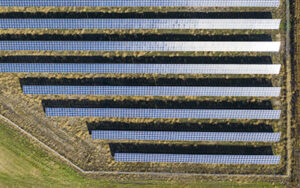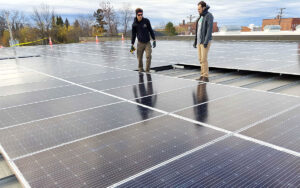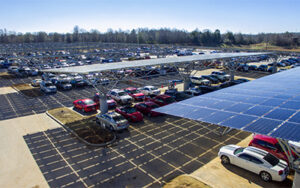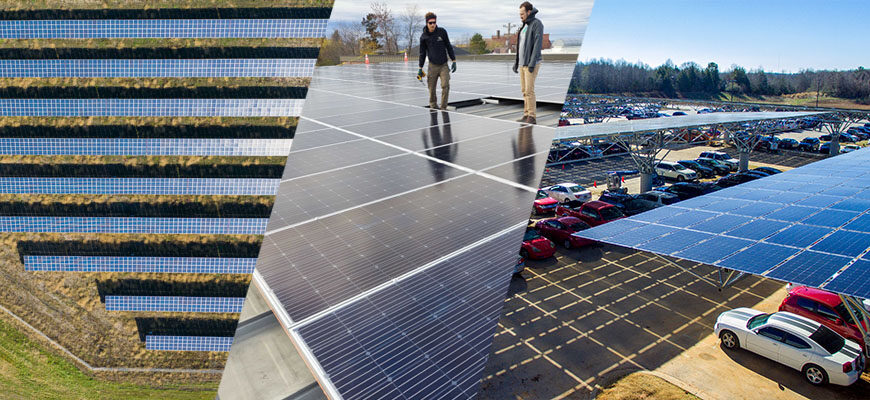- March 13, 2024
- by Nokomis Energy
We previously explored the topic of community solar, and how subscribing your business, organization, or municipality to one or more community solar gardens can allow you to capture the economic benefits of a solar system without having to install solar panels on your property or facilities.
But what if you do have a location that may be suitable for an onsite solar system? How do you make that determination and what might the economic benefits look like?
Use these steps to conduct an initial analysis and find out what might make sense for your particular scenario. If you determine onsite solar might be a good fit for your needs, we are here to help.
Goals
A helpful place to start is by determining your economic and environmental goals.
Here are a few common goals to get the process started. Choose the ones that align most closely with your organization’s overall energy and economic strategies.
- Lower energy costs
- Fix all or a portion of your electricity costs for 20+ years
- Monetize underutilized space (ground, roof, parking areas)
- Add renewable energy to your local utility mix
- Satisfy your organization’s sustainability initiatives
- Receive lower cost of capital by satisfying Environmental, Social, and Governance (ESG) goals
- Deploy capital and take advantage of solar’s attractive risk-adjusted returns
- Meet employee demand to implement renewable energy
An onsite solar system can accomplish some (or even all) of these goals in the appropriate scenario.
Siting
The next step is to evaluate potential site locations close to your facility’s electricity loads.
This may seem like a straightforward task, but there are several ways to get creative.
Do you have acreage at or nearby your facility?

Ground mounted systems are a popular choice for onsite solar.
Ground-mounted solar is often what people think of when trying to determine if a particular site might be a good candidate for onsite solar. It is one of the most popular options and it’s relatively simple to calculate the output. For example, if you have 4+ acres of open ground near your facility, a solar array could generate over 2,000,000 kWh a year, which is a significant portion of usage for any large energy consumer. This presents an ideal scenario, but anywhere upward of 0.5 acres of open ground can be utilized for an onsite solar array.
Does your facility have a roof?

Rooftop solar system installation at the Ashland Area Development Corporation in northern Wisconsin. Click the photo to learn more.
Rooftop solar can be an ideal option due to its proximity to a facility’s electrical service. Here are a few general criteria to determine whether rooftop solar might be a good fit for your facility:
- Roof age – Solar systems are warranted to generate energy for 25+ years, so it’s best to consider roofs that are less than 5 years old.
- Roof type – Flat or metals roofs tend to be the best option and allow for an easy, lightweight installation.
- Usable space – For businesses, schools, or municipalities, it’s helpful to have 100,000+ square feet of usable space to capture the best economics solar has to offer.

Solar parking canopies can provide energy and protection.
Do you have a large lot for parking or vehicle storage?
Solar parking canopies can do double duty by generating a meaningful amount of energy for your facility, while providing the added benefit of protection from the elements.
Overall, evaluating where you might site your solar array is a key step to understanding if onsite solar makes sense for your property or real estate portfolio.
Utility Review
It’s important to understand the full scope of your electricity costs to accurately predict how much savings will be made available by installing solar.
There is a wealth of information available on your energy bill. First, review your “kWh” usage to get the data you will need to determine your actual annual energy usage and costs. This allows you to estimate how much energy you need to produce, what size your solar system should be and how much it will save.
Next, check with your utility to find out their rules on how much solar can be added to any given site or utility territory. They may also have programs and incentives available, but each utility is different so it’s important to contact yours.
TIP: If you’re working with a solar developer, be sure they have local expertise so they can help you incorporate the utility-specific rules and incentives into your plan.
Incentives
Federal, state, local, and utility incentives can help dramatically offset the initial costs of your solar system.
These incentives are designed to reflect the value of deploying clean energy, but they can vary widely, depending upon the location of your site. Be sure your solar developer is familiar with your region, so you can benefit from all available incentives.
At this time, there are two key federal tax incentives that can be applied to defray ~50% of your solar system’s cost.
- The Section 48 Investment Tax Credit (ITC), originally introduced in 2005, has been the main driver of the deployment of solar energy in the U.S. Currently, commercial solar system owners receive a 30% tax credit, which is a dollar-for-dollar reduction in taxes otherwise payment, equal to 30%. For example, a $1,000,000 solar system will receive a $300,000 tax break in the first year of the solar system’s operation. Under the Inflation Reduction Act, there are also bonus credits (on top of the 30% ITC base credit) for systems that meet certain conditions, including those using domestic content, located in energy or low-income communities, meeting certain labor requirements.
- The cost of a solar system can be depreciated in year 1 through IRS Section 168(k), which allows taxpayers to expense 100% of the cost of qualified assets bought and placed in service. This equates to ~25% of the cost of a solar system.
Economic Options
Hosting onsite solar doesn’t require you to own the system outright, although that may make sense.
Once the siting, utility review, and incentives have all been considered, it’s time to evaluate what kind of ownership model might be the best fit.
- Ownership – By owning your solar system outright, you can realize a strong return on investment by taking advantage of the Federal tax benefits and energy savings over the long life of the solar energy assets (generally 25+ years).
- Power Purchase Agreement (PPA) – In the event your organization does not pay or owe Federal taxes, a no-capital outlay solution might be a better fit. By agreeing to host the solar system and purchase the solar energy over time, organizations can often still go solar, save money and fix a portion of your energy bill.
- Site Lease – In certain areas, it’s possible to simply lease your underutilized ground, roof, or parking area and generate recurring income for 20+ years.
Congratulations! You have taken the first steps to determine your goals, evaluate your site and understand the incentives and ownership models. You should now have enough information to determine whether or not you would be a good candidate for an onsite solar system.
Learn More
Does it seem like onsite solar might be a good solution to meet your economic and energy goals? Fill out the form below to get started.
Nokomis Energy is a clean energy developer based in Minneapolis, Minnesota. Our mission is to identify opportunities to create clean, low-cost energy projects for our customers. We work directly with our customers and partners to implement and build clean energy solutions that work for your specific needs.

